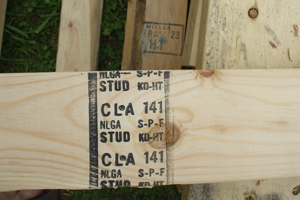
Am I taking recycling too far? I have a source for recycled pine , but not from New Zealand (where I live). Yep, all the way from the US of A. This is used as pallets to ship Polaris quad bikes/farm vehicles to us. Each pallet is just a tad under 3 meters long and has 10 lengths 95mm x 45mm ; 10 lengths 65mm x40mm and 2 lengths 150mm x 40mm ; and that is just the base. Sides/ends are 100mm x 20mm covered with printed building wrap. I would appreciate some advice: the markings on the timber are unknown to anybody in the trade here in New Zealand. We assume that it is kiln dried (KD) and what we refer to here as LaserFrame (albeit No 2 Grade) but would appreciate some interpretation of the marks, and can you advise the type of pine? Some of the pieces appear (and smell) like sugar pine, and some have the mark CAN on them … Canadian maybe? What the heck, it’s free, it’s clean and it’s dry. Even the wrapping gets reused at my place — makes great weed matt for the garden. – Lou A. Hocken
Chris Marshall: If you are taking recycling too far by using pallet lumber, you are definitely in good company. We once queried readers in a blog post for how they use pallet lumber, and the response was lively. Here’s a link if you want to check it out.
Now, concerning the grade stamps on the piece of lumber you’ve provided in your photo. Here’s how it breaks down, specifically, reading clockwise:
CLA/NLGA: These are two associations that establish and enforce the grading rules for Canadian lumber. CLA is the Canadian Lumbermen’s Association, and NLGA is the National Lumber Grades Authority.
141: The mill from which this particular piece of lumber originated.
S-P-F: The general species category of Spruce Pine Fir. Any number of softwood species fall under this abbreviation, so it’s hard to know exactly what you’ve got. But, given that you’re recycling packaging and shipping materials here, whatever lumber commodity was cheapest at the time is probably what was used.
KD-HT: Kiln Dried and Heat Treated is a requirement for wood packaging materials that may be exported. Heat treatment kills insects that could potentially be invasively damaging to another part of the world.
Stud: This a “stud grade” piece of structural lumber, so it can contain a greater number of allowable defects than, say, “Sel Str” (Select Structural) or “No. 1 & Btr.” There are eight grades of structural lumber, and “Stud” grade falls near the bottom of the list for highest percentages of allowable defects.
Tim Inman: Since I’m primarily a “furniture guy” and not too familiar with construction lumber, I’ll let others who might know the markings better answer your question regarding the “lingo” or vernacular meanings of the markings. I will add this, though — from many years of experience. Unless you have a specific reason for wanting to use this lumber, please pass on it and get some nice wood to work with. The time you spend creating a project is the same, whether you use nice hardwoods or ‘”scrap lumber” that is cheap. Now don’t underestimate me. I’m from Iowa, and I have a serious case of the “Iowa Cheaps” most of the time. I like to get the most mileage out of anything that comes in my way. But, too often, after hours of work, I have wished I had used better materials.





